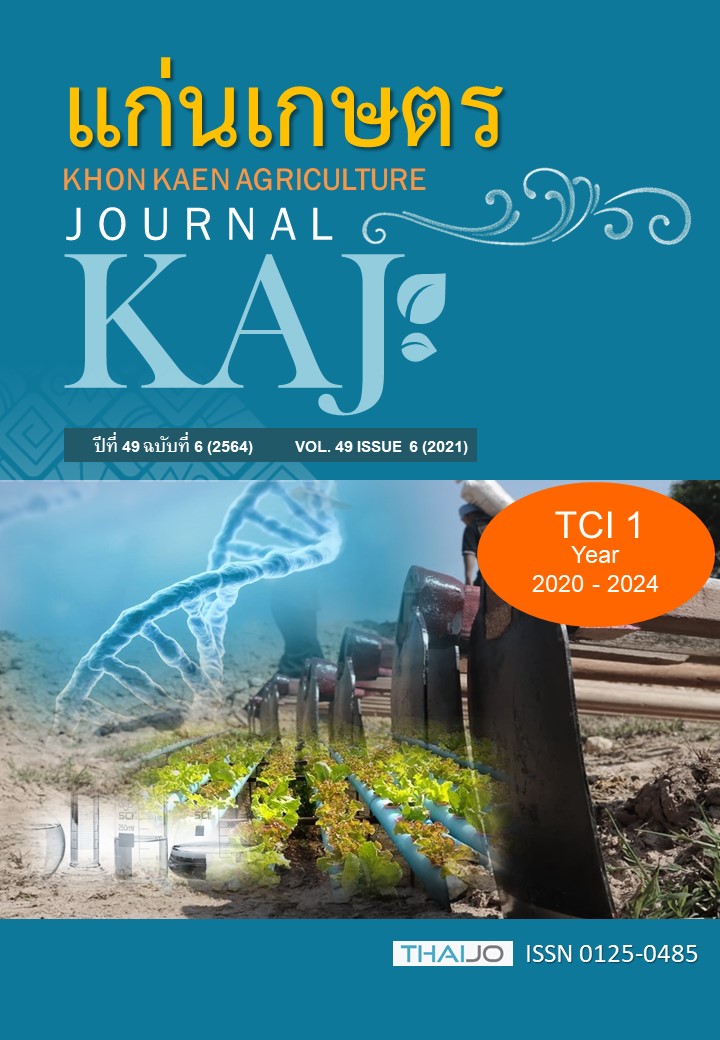ผลของการใช้ปุ๋ยตามคำแนะนำของแอพพลิเคชั่น All-rice1 ต่อการเจริญเติบโต องค์ประกอบผลผลิต ผลตอบแทนและผลกระทบต่อสิ่งแวดล้อมของพื้นที่ปลูกข้าวในจังหวัดเพชรบุรี
Main Article Content
บทคัดย่อ
การใส่ปุ๋ยในปริมาณที่ไม่สอดคล้องกับความต้องการธาตุอาหารของข้าวและไม่คำนึงถึงความอุดมสมบูรณ์ของดินส่งผลต่อการให้ผลผลิต ต้นทุนการผลิตและผลกระทบต่อสิ่งแวดล้อมของระบบการปลูกข้าว การศึกษานี้มีวัตถุประสงค์เพื่อเปรียบเทียบการใช้เทคโนโลยีการจัดการปุ๋ยที่แม่นยำโดยใช้แอปพลิเคชัน All-rice1 และการใส่ปุ๋ยตามวิธีการของเกษตรกรที่มีต่อลักษณะทางการเกษตร ลักษณะทางเศรษฐศาสตร์และผลกระทบทางด้านสิ่งแวดล้อมของข้าวในพื้นที่จังหวัดเพชรบุรี ผลการทดลอง พบว่า การใส่ปุ๋ยทั้ง 2 รูปแบบ ทำให้ข้าวมีองค์ประกอบผลผลิต (จำนวนเมล็ดต่อรวง น้ำหนักเมล็ดดี 1,000 เมล็ด ร้อยละของเมล็ดดีและร้อยละของเมล็ดลีบ) และต้นทุนการผลิตไม่แตกต่างกัน (P>0.05) แต่การใส่ปุ๋ยตามคำแนะนำของ All-rice1 ทำให้ข้าวมีผลผลิตข้าวเปลือกเพิ่มขึ้น 142 กิโลกรัมต่อไร่ หรือ คิดเป็นร้อยละ 20 (P<0.05) และมีกำไรสุทธิเพิ่มขึ้น 1,187 บาทต่อไร่ หรือคิดเป็นร้อยละ 81 นอกจากนี้ การใส่ปุ๋ยตามคำแนะนำของ All-rice1 ทำให้ตัวชี้วัดทางด้านสิ่งแวดล้อม ได้แก่ ค่าดัชนีการเปลี่ยนแปลงสภาพภูมิอากาศ ค่าดัชนีการทำให้เกิดฝนกรด และค่าดัชนีการปนเปื้อนของมหาสมุทรลดลง (P<0.05) ร้อยละ 20 27 และ 25 ตามลำดับ ดังนั้น การใส่ปุ๋ยตามคำแนะนำของ All-rice1 ซึ่งมีการคำนึงถึงความต้องการธาตุอาหารของข้าวและธาตุอาหารที่มีในดินเป็นหนึ่งในแนวทางการจัดการปุ๋ยที่ช่วยเพิ่มประสิทธิภาพการปลูกข้าว
Article Details

อนุญาตภายใต้เงื่อนไข Creative Commons Attribution-NonCommercial-NoDerivatives 4.0 International License.
เอกสารอ้างอิง
กรมพัฒนาที่ดิน. 2548. ชุดดินสรรพยา. น. 37. ใน: เอกสารวิชาการ ลักษณะและสมบัติของชุดดินในภาคกลางของประเทศไทย. กรมพัฒนาที่ดิน กรุงเทพฯ.
ธนกฤต เขียวอร่าม และอุไรวรรณ ไอยสุวรรณ์. 2561. ผลของการจัดการรูปแบบปุ๋ยที่มีต่อการให้ผลผลิตและประสิทธิภาพการใช้ปุ๋ยของข้าวพันธุ์ปทุมธานี 1 ที่ปลูกในชุดดินสมุทรปราการ. น. 274-279. ใน: การประชุมวิชาการและนำเสนอผลงานวิจัยระดับชาติ ราชธานีวิชาการ ครั้งที่ 3 เรื่อง นวัตกรรมที่พลิกโฉมสังคมโลก 29 กรกฎาคม 2561. มหาวิทยาลัยราชธานี, อุบลราชธานี.
ยงยุทธ โอสถสภา อรรถศิษฐ์ วงศ์มณีโรจน์ และชวลิต ฮงประยูร. 2551. ปุ๋ยเพื่อการเกษตรยั่งยืน. สำนักพิมพ์มหาวิทยาลัยเกษตรศาสตร์, กรุงเทพมหานคร.
อุไรวรรณ ไอยสุวรรณ์. 2557. การจัดการปุ๋ยตามค่าวิเคราะห์ดินต่อการเจริญเติบโต ผลผลิต และประสิทธิภาพการใช้ไนโตรเจนของข้าวที่ปลูกในชุดดินสรรพยา. วารสารเกษตร. 30: 133-140.
Brodt, S., A. Kendall, Y. Mohammadi, A. Arslan, J. Yuan, I.N. Lee and B. Linquist. 2014. Life cycle greenhouse gas emissions in California rice production. Field Crops Research. 169: 89–98.
Ecoinvent Centre. 2018. ecoinvent data v3.4. Swiss Centre for Life Cycle Inventories, St. Gallen.
FAOSTAT. 2021. Faostat. Available: www.fao.org. Accessed March 15, 2021.
Fageria, N. K. 2007. Yield physiology of rice. Journal of Plant Nutrition. 30: 843-879.
Hasler, K., S. Bröring, S.W.F. Omta, and H.W. Olfs. 2015. Life cycle assessment (LCA) of different fertilizer product types. European Journal of Agronomy. 69: 41-51.
IPCC (Intergovernmental Panel on Climate Change). 2006. Chapter 11: N2O emissions from managed soils, and CO2 emissions from lime and urea application. P. 4.1- 4.83. In: Eggleston HS, Buendia L, Miwa K, Ngara T, Tanabe K (eds.). 2006 IPCC Guidelines for National Greenhouse Gas Inventories: Volume 4 Agriculture. Forestry and Other Land Use Global Environmental Strategies, Kanagawa, Japan.
Isuwan, A., J. Chobtang, and W. Sirirotjanaput. 2018. Economic and environmental sustainability of rice farming systems in Thailand. In The 11th International Conference on Life Cycle Assessment of Food (LCA FOOD 2018). pp. 300-303. In conjunction with the 6th LCA AgriFood Asia and the 7th International Conference on Green and Sustainable Innovation (ICGSI). 16-20 October 2018.
Isuwan, A., and T. Keawaram. 2021. Effects of fertilizer regimes on growth yields and economic returns of Pathum Thani 1 rice grown on Sapphaya Soil Series. Walailak Journal. 18(2): 6838.
Kassam, A., and H. Brammer. 2016. Environmental implications of three modern agricultural practices: Conservation Agriculture, the System of Rice Intensification and Precision Agriculture. International Journal of Environmental Studies. 73: 702-718.
Myhre G.D.S., F.M. Bréon, W. Collins, J. Fuglestvedt, J. Huang, D. Koch, J.F. Lamarque, D. Lee, B. Mendoza T. Nakajima, A. Robock, G. Stephens, T. Takemura, and H. Zhang. 2013. Anthropogenic and natural radiative forcing. pp 659-740. In: Stocker TF, Qin D, Plattner G-K et al. (eds.). Climate Change 2013: The Physical Science Basis. Contribution of Working Group I to the Fifth Assessment Report of the Intergovernmental Panel on Climate Change. Cambridge University Press, Cambridge, United Kingdom and New York, USA.
Nemecek, T., J. Schnetzer, and J. Reinhard. 2016. Updated and harmonised greenhouse gas emissions for crop inventories. International Journal of Life Cycle Assessment. 21: 1361–1378.
Nunes, F.A., M. Seferin, V.G. Maciel, S.H. Flôres, and M.A.Z. Ayub. 2016. Life cycle greenhouse gas emissions from rice production systems in Brazil: A comparison between minimal tillage and organic farming. Journal of Cleaner Production. 139: 799-809.
Posch, M., J. Seppälä, J.P. Hettelingh, M. Johansson, M. Margni, and O. Jolliet. 2008. The role of atmospheric dispersion models and ecosystem sensitivity in the determination of characterization factors for acidifying and eutrophying emissions in LCIA. International Journal of Life Cycle Assessment. 13: 477-486.
Pré Consultants. 2018. SimaPro 8.3 Life Cycle Assessment Software, Amersfoort, The Netherlands.
Rafiqul, I., C. Weber, B. Lehmann, and A.Voss. 2005. Energy efficiency improvements in ammonia production—perspectives and uncertainties. Energy. 30: 2487-2504.
SAS. 2003. Statistical Analysis System. SAS Release 9.1 for Windows. SAS Institute Inc. Cary, NC, USA.
Seppälä, J., M. Posch, M. Johansson, and J.P. Hettelingh. 2006. Country-dependent characterization factors for Acidification and Terrestrial Eutrophication based on Accumulated Exceedance as an impact category indicator. International Journal of Life Cycle Assessment. 11: 403-416.
Smith, P., D. Martino, and Z. Cai. 2007. Agriculture. P. 497–540. In: Climate Change: Mitigation. Contribution of Working Group III to the Fourth Assessment Report of the Intergovernmental Panel on Climate Change; Metz, B., Davidson, O.R., Bosch, P.R., Dave, R., Meyer, L.A., Eds.; Cambridge University Press: Cambridge, UK; New York, NY, USA.
Struijs, J., A.H.W. Beusen, H. van Jaarsveld, and M.A.J. Huijbregts. 2009. Chapter 6. Aquatic eutrophication. [Online]. Available: http://www.lcia-recipe.net. Accessed April 13, 2016.
Thanawong, K., S.R. Perret, and C. Basset-Mens. 2014. Eco-efficiency of paddy rice production in Northeastern Thailand: a comparison of rain-fed and irrigated cropping systems. Journal of Cleaner Production. 73: 204-217.
Van Groenigen, K.J., C. van Kessel, and B.A. Hungate. 2013. Increased greenhouse-gas intensity of rice production under future atmospheric conditions. Natural Climate Chang. 3: 288–291.


